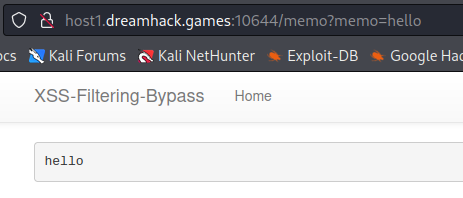XSS Filtering Bypass
Enumeration
Reading app.py reveals its mechanics.
XSS Filtering Bypassworks the same as xss-1 except for the new code which sanitizes input ofscript,onandjavascript.
┌──(m0nk3y@kali)-[~/DH/XSS Filtering Bypass]
└─$ cat app.py
#!/usr/bin/python3
from flask import Flask, request, render_template
from selenium import webdriver
import urllib
import os
app = Flask(__name__)
app.secret_key = os.urandom(32)
try:
FLAG = open("./flag.txt", "r").read()
except:
FLAG = "[**FLAG**]"
def read_url(url, cookie={"name": "name", "value": "value"}):
cookie.update({"domain": "127.0.0.1"})
try:
options = webdriver.ChromeOptions()
for _ in [
"headless",
"window-size=1920x1080",
"disable-gpu",
"no-sandbox",
"disable-dev-shm-usage",
]:
options.add_argument(_)
driver = webdriver.Chrome("/chromedriver", options=options)
driver.implicitly_wait(3)
driver.set_page_load_timeout(3)
driver.get("http://127.0.0.1:8000/")
driver.add_cookie(cookie)
driver.get(url)
except Exception as e:
driver.quit()
# return str(e)
return False
driver.quit()
return True
def check_xss(param, cookie={"name": "name", "value": "value"}):
url = f"http://127.0.0.1:8000/vuln?param={urllib.parse.quote(param)}"
return read_url(url, cookie)
def xss_filter(text):
_filter = ["script", "on", "javascript"]
for f in _filter:
if f in text.lower():
text = text.replace(f, "")
return text
@app.route("/")
def index():
return render_template("index.html")
@app.route("/vuln")
def vuln():
param = request.args.get("param", "")
param = xss_filter(param)
return param
@app.route("/flag", methods=["GET", "POST"])
def flag():
if request.method == "GET":
return render_template("flag.html")
elif request.method == "POST":
param = request.form.get("param")
if not check_xss(param, {"name": "flag", "value": FLAG.strip()}):
return '<script>alert("wrong??");history.go(-1);</script>'
return '<script>alert("good");history.go(-1);</script>'
memo_text = ""
@app.route("/memo")
def memo():
global memo_text
text = request.args.get("memo", "")
memo_text += text + "\n"
return render_template("memo.html", memo=memo_text)
app.run(host="0.0.0.0", port=8000)
Exploitation
vuln page is susceptible to a XSS injection.

memo page shows the contents saved by the get paramter memo.

Since the vuln page only replaces script, on, javascript once, parameter scrscriptipt will turn into script.

Post Exploitation
After a successful exploitation, I’m able to view the flag.

